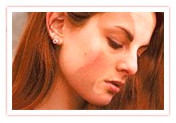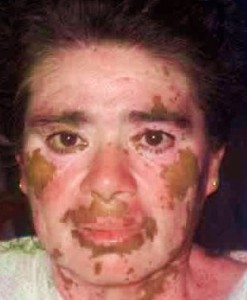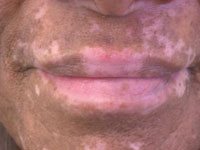White patches on the skin or skin depigmentation is one of the common auto-immune disorders . This kind of disorder known as Vitiligo develops mainly on the skin. It is really not harmful but can cause emotional and psychological distress to a person who has this kind of disorder. Studies show that around 0.5 to 1 percent of the world’s population has Vitiligo.
What is Vitiligo?
Vitiligo, pronounced as Vit-ill-EYE-go, is a disorder that turns the color of the skin from dark color to white, also known as depigmentation. This happens when the cells, called melanocytes stop functioning. The small white patches on the skin appear in such a way it becomes distinct from the natural skin color and becomes noticeable in the areas where it develops. These white patches on the skin may appear on several parts of the body particularly in the openings (mouth, nostrils), face, fingers and toes. Hair growth in the areas affected by the disorder becomes white. Vitiligo affects both men and women in all races.
What causes Vitiligo?
Although the cause cannot be determined, there are theories linking to the nature of the disorder. In one of the theories, it explains that Vitiligo is a type of autoimmune disease in which a person’s immune system reacts against the body’s own cells and tissues. Another theory states that nerve endings in the skin produce chemicals that destroy the melanocytes. The third theory explains that melanocytes destroy itself.
What are the signs and symptoms of Vitiligo?
When white patches on the skin start appearing on the body, this may indicate that a person has developed the disorder. Patches will appear small at first and tend to grow bigger and change shape. The white patches on the skin will start to appear on the face, hands, fingers and toes. It can also develop in the openings particularly in the linings of the mouth, in the nostrils and in the eyes where the retina becomes inflamed.
What are the types of Vitiligo?
There are two types of this disorder, the non-segmental (NSV) and segmental Vitiligo. In non-segmental Vitiligo, the white patches on the skin are symmetrically formed and these patches appear from time to time. It can appear at any age. In the segmental Vitiligo, it commonly affects areas with the dorsal roots from the spine. It develops rapidly compared with non-segmental Vitiligo. It tends to develop in the teenage years. A Vitiligo that remains permanent on the skin is known as Vitiligo Universalis.
How does Vitiligo develop?
The development of white patches on the skin depends on the person who has the disorder. In fair or white skinned individuals, it can be noticed if the natural skin becomes distinct from the areas that has Vitiligo. People with dark skin will notice the white patches on the skin right away. In severe cases, Vitiligo will develop on the whole surface of the body. Physical and emotional stress also contributes in the development of Vitiligo. The growth depends on the pigment loss on the surface of the skin and may continue to grow in time.
Is there a cure for Vitiligo?
When small white patches on the skin appear, it tends to remain on the skin. Some of these patches grow bigger. Patients who are experiencing rapid growth can have the disorder treated. There are several treatments than can be applied such as medication, therapies and surgery. Patients undergoing treatments may respond differently. It is possible that other treatments will not work for others. Known medical therapies that can help reduce the appearance are:
1. Depigmentation
This kind of treatment makes the unaffected areas fade so it will match the white areas on the body. A type of medication known as monobenzyl ether of hydroquinone is applied twice daily to the pigmented areas until they match with the depigmented areas. After application, skin to skin contact with other people should be avoided for at least two hours since the drug may also transfer depigmentation to the another person. There are side effects however with this treatment. The skin becomes inflamed, and there is also itchiness and dryness on the skin.
2. Psoralen Photochemotherapy
Also known as psoralen and ultraviolet A therapy (PUVA), this treatment is very effective for Vitiligo. Treatment can be applied in two ways, orally and topically. After medication is taken, the skin is exposed to the sun rays or to a special lamp that releases ultraviolet A (UVA) light.
3. Topical Steroid Therapy
Treatment for this therapy is the application of cream to the white patches on the skin for a period of 3 months. A specific cream known as Corticosteroid is used topically on the surface of the affected area. However, there are indications that it can cause side effects. Treatment for this is procedure is being closely monitored by the doctor.
4. Surgical Therapy
It is proper that a medical therapy should first be performed before a surgical therapy since surgery is very expensive and consumes time. Types of surgical therapy are:
• Autologous skin graft. This procedure is done by removing skin from one area and is attached to another area of the body.
• Skin grafts using blisters. Heat, suction and freezing cold is used to create blisters on pigmented skin and the tops of the blisters are cut out and transplanted to the depigmented skin area.
• Micropigmentation. Pigments are implanted on the skin with special surgical instrument.
• Autologous melanocyte transplants. Meloncytes are cultured and multiplied which are taken from pigmented skin and are transplanted to the depigmented skin patches.
There are other therapies that can be applied aside from medical and surgical therapies to the white patches on the skin such as sunscreens which are helpful in protecting the skin from sunburn and damage to the skin. Cosmetics also help protect and cover the white patches on the skin.
What are the psychological implications of Vitiligo to a person who has the disorder?
Vitiligo is not harmful and is painless but it can cause emotional, physical and psychological distress. A person with Vitiligo may experience discomfort and discrimination because of his physical appearance. The white patches on the skin are abnormalities which can make a person feel insecure with the way he looks. If Vitiligo is visibly present on the body such as on the hands, fingers and face, a person may inhibit himself from being seen in public. The disorder affects the normal life of a person if he is conscious about his appearance.



I am grateful for your post. I’d prefer to comment that the tariff of car insurance differs a lot from one insurance plan to another, for the reason that there are so many different issues which contribute to the overall cost. For instance, the brand name of the car will have a tremendous bearing on the charge. A reliable ancient family motor vehicle will have a more affordable premium than a flashy sports car.